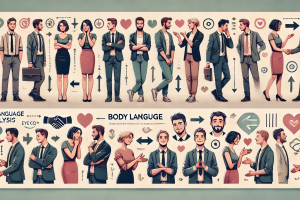How to Read and Understand Body Language: A Guide to Interpreting Nonverbal Cues
- Posted by Noah Thompson (Australia)
- Categories General
- Date September 17, 2024
Body language is a powerful form of nonverbal communication that we use every day, often without realizing it. From the way we stand to subtle facial expressions, our bodies convey messages that words sometimes cannot. Understanding body language can improve your interactions, help you build stronger connections, and even allow you to gauge others’ emotions more accurately.
In this guide, we’ll dive into how to read and understand body language, breaking down key body language signs, and offering tips on how to become more aware of your own nonverbal cues. Let’s explore how mastering body language can give you an edge in both social and professional settings.
What Is Body Language?
The Basics of Body Language
At its core, body language refers to the nonverbal communication we express through gestures, posture, eye contact, and facial expressions. It’s often described as the “silent language” because, although it’s wordless, it conveys volumes of information. From a smile that communicates warmth to a crossed arm that shows defensiveness, body language can be more telling than spoken words.
Understanding body language is key to interpreting the emotions and intentions of others, as well as controlling how you’re perceived in various settings. Whether you’re in a job interview, a social gathering, or even a date, being mindful of your body language can enhance your communication skills and leave a lasting impression.
Common Body Language Signs and What They Mean
Positive and Open Body Language
When you’re engaging with someone, it’s crucial to recognize the signs of positive body language. These nonverbal cues signal openness, attentiveness, and comfort. Understanding these can help you gauge how receptive someone is to your conversation.
- Open posture: When someone stands or sits with their arms uncrossed and their body facing you, it shows they are open and engaged.
- Steady eye contact: Holding eye contact without staring signals confidence and interest. It shows you’re paying attention and are present in the conversation.
- Genuine smile: A real smile, where the eyes crinkle slightly, is a universal sign of warmth and friendliness.
- Leaning slightly forward: This gesture can indicate interest and attentiveness, especially in one-on-one conversations.
Negative or Defensive Body Language
On the flip side, recognizing defensive or closed-off body language signs is equally important. These signals often indicate discomfort, disinterest, or anxiety.
- Crossed arms: Often interpreted as a sign of defensiveness or resistance, crossing arms can create a physical barrier that communicates discomfort or opposition.
- Avoiding eye contact: Shifting or avoiding eye contact may indicate that someone feels uncomfortable, uninterested, or even dishonest.
- Fidgeting: Playing with objects, tapping feet, or shifting in the seat often signifies nervousness or impatience.
- Turning away: A person who consistently turns their body away during conversation may be signaling disinterest or a desire to exit the interaction.
Key takeaway: Recognizing both positive body language and defensive body language can significantly enhance your ability to interpret nonverbal cues during social interactions.
How to Read Body Language in Different Settings
Body Language in Communication
Whether in professional settings like meetings or personal conversations, body language in communication plays a significant role in how messages are conveyed and received. Studies suggest that as much as 55% of communication is nonverbal, making body language critical to how we interpret interactions.
In workplace settings, maintaining positive body language can make you seem more confident and approachable. This includes gestures like a firm handshake, making eye contact during presentations, and sitting with an open posture during discussions. Conversely, avoiding fidgeting and crossing your arms can help you project a more confident and composed image.
Key tip: In professional environments, focus on maintaining open, calm, and confident body language to enhance your credibility and engagement.
How to Read Body Language in Social Situations
Reading body language in more casual social settings, like parties or dates, can provide deeper insights into the other person’s feelings and engagement levels. Here are a few tips on how to understand body language in these scenarios:
- Mirroring: When someone subconsciously mirrors your gestures or posture, it’s often a sign of rapport and mutual connection.
- Proximity: The distance someone maintains between themselves and others can be a strong indicator of comfort level. People tend to stand closer to those they trust and feel comfortable with.
- Touch: Light, non-invasive touches (like a pat on the back or a friendly arm touch) often signal warmth and affection. However, be mindful that personal space varies across cultures.
Key takeaway: In social settings, look for signs like mirroring and proximity to gauge comfort and connection.
Understanding Different Types of Body Language
Types of Body Language: From Head to Toe
There are various types of body language, and each part of the body tells a story. Here’s a breakdown of key types of body language to be aware of:
- Facial expressions: Smiling, frowning, raising eyebrows, and other facial movements are some of the most telling nonverbal signals.
- Hand gestures: Hand movements, from a simple wave to a firm handshake, convey different messages about openness, dominance, or uncertainty.
- Posture: The way someone stands or sits often reflects their confidence, attentiveness, or discomfort.
- Eye contact: Eye movements provide insight into a person’s focus, honesty, and emotional state.
- Touch: Whether it’s a handshake or a pat on the back, touch can signify anything from greeting to comfort and authority.
Key takeaway: Understanding the types of body language can improve your ability to read emotions, interpret intentions, and respond effectively.
The Importance of Positive Body Language
How Positive Body Language Can Impact Communication
Using positive body language effectively can transform the way others perceive you. When you consciously adopt open and confident gestures, you project trustworthiness, reliability, and warmth. This is especially important in professional and interpersonal relationships, as body language in communication can either enhance or diminish your message.
Here are some key elements of positive body language to adopt:
- Open stance: Keep your arms relaxed and avoid crossing them.
- Maintain eye contact: Look directly at the person you’re speaking with but avoid staring.
- Relax your shoulders: Tension in the shoulders can signal stress, so keep them relaxed and down.
By becoming aware of your own positive body language, you can ensure you’re sending the right signals, helping you create stronger connections and more effective communication.
Exploring the Psychology Behind Body Language
Body Language Psychology: The Science of Nonverbal Communication
The way we move and behave often reveals our underlying thoughts and emotions, which is where body language psychology comes into play. Understanding the psychological basis of body language offers deeper insights into why people behave the way they do in certain situations.
For example, body language psychology shows us that stress, fear, and insecurity often manifest physically through crossed arms, slumped shoulders, or avoidance of eye contact. By learning to identify these cues, you can better understand what someone might be feeling, even if their words don’t express it.
The field of nonverbal communication is rich with research that shows just how much our gestures and posture can communicate. Psychologists have found that nonverbal behaviors such as posture, facial expressions, and even micro-expressions often happen unconsciously, giving away our true emotions and thoughts.
Key takeaway: Understanding the psychology of body language allows you to better interpret hidden emotions and enhance your interactions by responding more empathetically.
Mastering Body Language for Improved Communication
Mastering body language is essential for better communication, stronger relationships, and greater emotional intelligence. Whether you’re learning to read body language signs in social situations or exploring how body language in communication can elevate your professional presence, understanding these nonverbal cues can have a significant impact on your success.
By recognizing the different types of body language and applying the principles of positive body language, you’ll be able to interpret others more accurately and express yourself more effectively. Don’t underestimate the power of body language—it can be the key to building deeper connections and improving how you’re perceived by others.
For more tips on enhancing your communication skills, check out Regent Studies, a valuable resource for learning more about human behavior and effective communication strategies.
Key takeaway: Mastering body language—from understanding key body language signs to learning the basics of body language psychology—is a vital skill for improving your relationships and communication skills.
For further insights into the importance of nonverbal communication in everyday life, check out Psychology Today’s article on nonverbal communication.
You may also like

How to Read Body Language: Mastering the Art of Non-Verbal Communication

Earbuds vs Headphones: Which Is Better for You?


